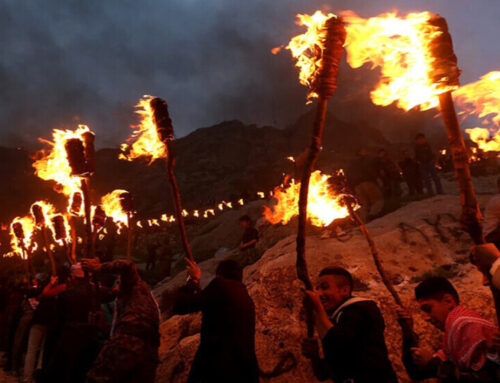How the PKK’s strength changed Turkey’s strategy towards the Kurds
How the PKK’s strength changed Turkey’s strategy towards the Kurds
- Date: July 11, 2021
- Categories:International

- Date: July 11, 2021
- Categories:International
How the PKK’s strength changed Turkey’s strategy towards the Kurds
Turkey recently targeted a refugee camp in Makhmour, near Erbil, the capital city of the KRI. Erdogan called the camp a threat, as grave as Qandil, where the PKK’s headquarters are located.
After four decades of fighting, nearly 40,000 casualties and billions of dollars, Turkey has failed to contain the Kurdistan Workers’ Party (PKK). Turkey has employed a new strategy: conducting military operations that create anti-PKK narratives that in turn lead to military victory. An insurgency thrives on popularity. Its strength and success depend on it. Turkey’s new strategy is designed to reduce the popularity of the PKK.
The PKK now has a presence in much of the Middle East. It has plans not only in the Middle East but in Europe and beyond. According to German intelligence, the PKK collects 25 million euros in Europe annually. The group and its offshoots control most of the inland territory lying south of the Turkish border. It is also one of the main sources of contention in American-Turkish relations. Turkish President Recep Tayyip Erdogan’s foreign policy of focusing on the Middle East is thwarted from the south due to the PKK. Breaking this hurdle requires the consent of the people inhabiting the region and the consent of the regional and great powers.
Turkey has designated the PKK as a terrorist organization. The aim is to remove it from its popular base. A senior Kurdish leader recently asked the Kurdish parties of Iraqi Kurdistan to label the PKK a terrorist organization. Nonetheless, the PKK is considered the guardian of the Kurds in almost all Kurdish inhabited regions.
As the group’s strength lies in its popularity, assaulting the group’s cause will be a cheaper and more effective strategy. More importantly, the central difference between a terrorist and an insurgent organization is popular support. Convincing the Kurds that the PKK is composed of a bunch of terrorists can deprive the group of its base. As military means are exhausted, Ankara has begun a three-phased strategy. The first phase of the strategy is using military operations that are conducive to creating a mesmerizing narrative.
Formerly, Ankara kept its military operations secret, but recent ones have been promoted. Many are touted by the Turkish president. The strikes are no longer limited to uninhabited mountains but includes an area that gathers most media attention and brings PKK fighters closer to the Peshmerga of the Kurdistan Region of Iraq (KRI). Sometimes operations are conducted deep within Iraqi territory.
Turkey recently targeted a refugee camp in Makhmour, near Erbil, the capital city of the KRI. Erdogan called the camp a threat, as grave as Qandil, where the PKK’s headquarters are located. It is unclear how the camp could threaten Turkey from 180 kilometers south of the Turkish border. The strike on Makhmour was possibly designed to distance Turkey from a major strike that happened on the same day.
In that strike, five Peshmerga from Iraqi Kurdistan were killed in a military vehicle near Erbil. The incident brought Kurdish authorities and the PKK to the brink of a civil war. The Peshmerga have been lately positioned near Qandil to limit the Turkish-PKK war to the mountains. Even though it was a surgical strike, it promoted a wide anti-PKK narrative.
KRI Prime Minister Masrour Barzani held the PKK responsible for the killing of Peshmerga members. The statement was followed by a similar one from Iraqi President Barham Salih, a Kurd, which questioned the legality of the group’s presence in the region.
However, military experts claimed that the Peshmerga were not hit by a rocket launcher but an airstrike as, notably, the PKK lack aircraft. The vehicle’s tires were intact while its roof was blown up, the explanation continued. The PKK denied its involvement and demanded an investigation into the incident. Nonetheless, this strike stoked anti-PKK stories.
THE PKK doesn’t want to antagonize the KRI. The region is of paramount importance to the organization. Its guerrillas and assets are located there. The region serves as a land bridge between PKK headquarters in Qandil and its forces in Iraq, Turkey, Syria and Iran. Iran is the PKK’s main supporter and its usual exit to the outer world. However, most observers do not analyze the region’s geopolitical complexities and instead consume their daily information from social media, where the battle of stories is fought, paving the way for an anti-PKK narrative.
The strikes stoked anti-PKK stories, creating an impression that the airstrikes depend on the group’s presence. The response on social media was mixed, though it promoted questions regarding the PKK’s goals and activities.
In an interview, a top Peshmerga commander and incumbent deputy president of KRI undermined the group’s efforts in defeating ISIS, and called their efforts propaganda. Narratives such as these would oblige the PKK to limit its activities in the KRI to satisfy its people and government. The story has imposed limits on PKK activity, as intended in the third phase of the cycle.
The KRI has mobilized its peshmerga closer to PKK bases. The rebels had no option but to accommodate, because clashing with their Kurdish brethren would mean civil war and would help to promote Turkey’s stories. For the PKK to avoid a civil war it has to limit its activities. Currently, the KRI doesn’t tolerate an active PKK on its northern borders, bringing the third phase to a close. This translated to a military victory for Turkey through its new strategy. Moreover, only the impression of civil war could contain the PKK, not an actual one.
Presently, forces loyal to the PKK are surrounding the KRI. The Patriotic Union of Kurdistan (PUK), which controls the KRI Peshmerga, has declared its neutrality, leaving the KDP alone, which is also unlikely to fight the group. If a war breaks out, Turkish forces would be invited to Iraqi Kurdistan, which will strengthen the PKK’s popularity. It will be touted as the guardian of KRI, a narrative that Turkey would want to prevent.
Additionally, in 1995, a Turkish force of 35,000 troops invaded Iraqi Kurdistan. Yet it failed to expel the PKK from the region despite the fact that the group was limited to a number of mountains. What’s more, in the 1990s, Turkey backed the PUK and the KDP to fight the PKK, even though in the 1980s the PUK and the KDP had veteran guerrillas who had operated in Qandil, however, they failed to expel the PKK from Qandil. Now Peshmerga forces with Iraqi Kurdistan are untrained and lack counterinsurgency skills.
Crucially, every single Kurd denounces intra-Kurdish fratricide.
The civil war in the 1990s didn’t promote an anti-PKK story because Ankara believed it could defeat the group militarily.
Furthermore, the PKK was not belligerent and the Kurds were fighting at Turkey’s behest. Kurds didn’t possess means of communication but now Kurdish-populated territories are among the most connected in the world. The Peshmerga’s confrontation with the rebels is to limit, not fight them. Thus the strategy employs military means for creating stories, not immediate military gains.
Currently, the PKK and its sponsored groups dot the map of the Middle East. As the second most powerful military in NATO, Turkey had failed to contain the group. This is why it has resorted to a systematic war of narratives against the PKK. However, it remains to be seen how Turkey’s three-phased strategy will unfold in the future.
The writer is a researcher and journalist covering the Middle East. His work has been published in The Jerusalem Post, The National Interest and various Kurdish magazines. He was the former editor in chief of the Birst newspaper.








Leave A Comment